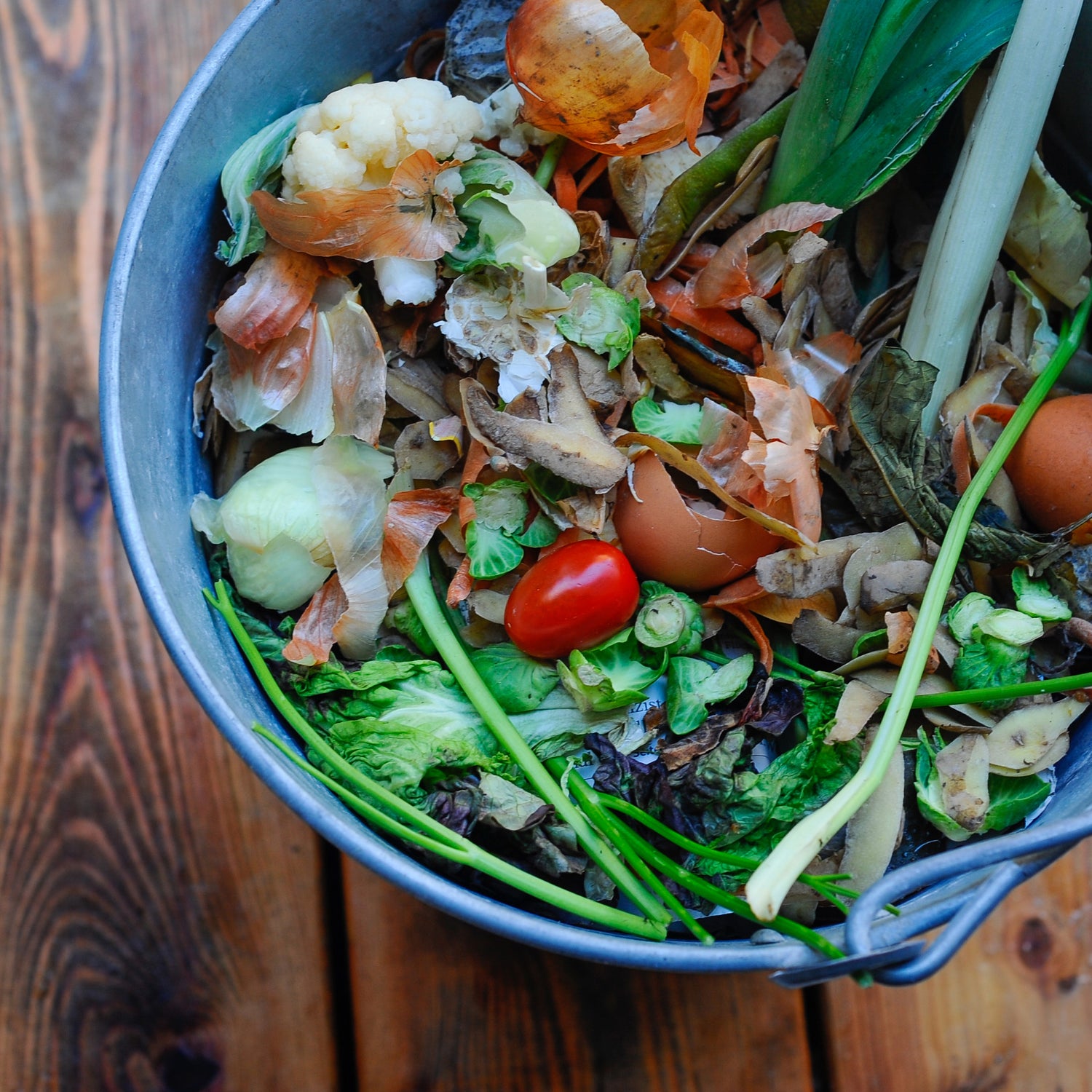
What a lot of rot!
You know what they say about composting behind its back? That it stinks, it attracts mice and creepy-crawlies and it’s all just a bit gross. Any compost lover will tell you it’s just not true! Healthy compost smells like soil, and those mice will be there no matter what you do.
You know what really is gross? A country overrun with landfills that emit methane – a greenhouse that’s 84 times more potent than carbon dioxide.
And it’s your old avocado skins, banana peels and broccoli stalks that are doing a lot of the emitting. That’s because in landfills, organic waste decomposes anaerobically – that is, without oxygen1, which produces far more methane.
So chucking your food scraps into the bin isn’t just a terrible waste of delicious nutrients that could be going back into the soil, it’s also supporting toxic landfills and contributing to climate change.
Instead of spending hundreds on fertilisers and plant foods for our home gardens, why not make the most of that huge source of plant happiness – your dinner scraps! As much as 50% of our waste stream to landfill could be food waste, which could be going back into the soil. Your compost heap is simply encouraging a natural process (food rot) so it happens a little quicker. Microbes break down food scraps into their components, like oxygen and nitrogen. The outcome? A nutrient-rich soil conditioner.
Composting - some options
The goal is to turn your kitchen and garden waste into usable soil, but there are a number of ways of going about it.
Anaerobic - stinky, slow but almost zero work
This is composting without oxygen. It’s the style of compost heap you’re probably more familiar with – you pile up food scraps with layers of newspaper or shredded coconut fibre and forget about it. This is the type of compost that can start to stink. Anaerobic composting also produces much more methane than aerobic, so it’s not the greatest option.
Aerobic - fast, and almost stink-free
Faster and less stinky, aerobic composting can require more work – you’ll need to get more air into your composting matter, which means turning or tossing it with a garden fork. A drum-style composter makes it easier to turn – you just roll it around.
What you put on your heap will help, too. The ideal is to build your heap in layers of ‘green’ (food scraps and grass clippings) and ‘brown’ (twigs, bark and crumbled paper or cardboard). Once you’ve built your heap, keep a pile of ‘brown’ sitting nearby to layer with any ‘green’ you add. This mix will also give your heap a good balance of carbon and nitrogen which helps assists with microbe growth’.
Look for a sheltered area, where your heap will be out of direct sunlight, wind and torrential rain. You can just pile it in a heap, or build a frame out of scrap wood. When you’re building the heap, dig a small trench and fill it 15cm (6 inches) with something like coconut husk or crumpled newspaper, then cover it with chicken wire or build a lattice out of sticks – this keeps your compost off the ground to let air circulate.
Many people find it useful to have two heaps on the go – one that they add to daily, and one that’s being left to compost. This means you have a heap that will soon be ready to fork into your garden, and another that’s ready to accept all your kitchen scraps. Otherwise, you’ll end up with compost mixed with still-rotting material.
If you’re just looking for a more environmentally friendly way to dispose of your kitchen scraps, and have the time and space to cope with slow-working heaps, then composting is fairly simple. But if your goal is to get great compost fast, it can be really complicated. You need to consider water content, nitrogen-carbon ratio, particle size, temperature and the size of the heap, otherwise decomposition is going to slow way down.
Bokashi - fermentation super boosting
If you want to get technical about it, a bokashi system isn’t actually composting. It uses fermentation, and the contents of the bucket will need to be emptied into a compost heap or buried every couple of weeks, so really I’m not entirely sure what the point is. It is fast, doesn’t need turning and can take all sorts of waste (including animal products). Apartment dwellers find bokashi a great option - but you do still need somewhere to put the waste once it’s fermented. You can buy commercial bucket systems that will make it easy to press the air out of your waste - an important part of fermentation. Then each time you add to your bokashi bin, you also add a handful of bokashi bran, which introduces the right microbes. You can get this at most hardware stores. The ‘tea’ bokashi produces is a fertiliser. The solid waste will smell a bit like pickles, and buried in the garden or added to compost acts as a super soil booster.

Vermicomposting (worms !)
This is my favourite method. Worm farms are built to allow lots of airflow, the special composting worms do all the work for you, and they usually do it far quicker than a backyard heap. They’re perfect if you’re in an apartment or if you can’t be bothered turning a compost heap.
All you need to do is get yourself a worm farm (there are loads on the market - extra points if you get one second-hand.) Then call in at your local garden centre for some special worms - most likely tiger worms. Acquaint yourself with what they will and will not eat (they don’t like onions or citrus skin, for example) then off you go!
A worm farm usually consists of a few layers: the catch at the bottom, the worm layer (or two) and a lid. They have a tap for draining off ‘worm juice’ (which is liquid gold for plants) and usually come with a nice thick pad of coconut fibre where you pile up the scraps.
They need a bit of roughage like cardboard and paper, but otherwise, it’s a pretty low-maintenance, thought-free way of lowering your food waste to landfill.
Commercial composting
Commercial composting works pretty much the same as your home heap, but it’s supercharged. It has tightly controlled conditions, so that temperature and the mix of materials in the heap are ideal. This breaks down the materials faster, and makes it suitable for things you can’t really deal with in your home compost, like some compostable plastics.
Get rotting!
Everyone should have a compost! If I was supreme world leader I would make it mandatory, and I applaud those local governments who’ve started organic rubbish collections.
Done correctly, composting doesn’t smell, doesn’t encourage pests and will provide your garden (or house plants) with lots of delicious goodness. It’s all win, while also avoiding major losses – greenhouse gasses, overflowing landfills and stinky rubbish bins!
Sources:
Geoghegan, E. K., Cardon, Z., & Vallino, J. J. Decomposition and methane production in anaerobic environments: a case study in a methanogenic bioreactor.




